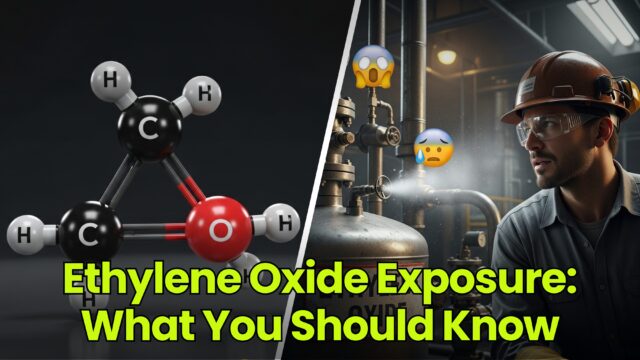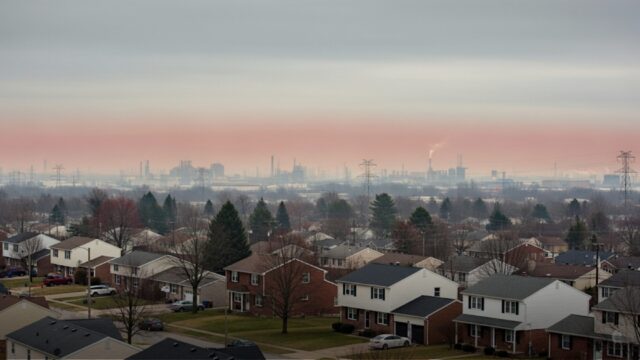Ethylene Oxide Exposure: What You Should Know
You’ve probably never heard of ethylene oxide exposure—but trust me, your lungs, DNA, and possibly future self wish you had. This gas might sound all science-fair and chemistry-class, but it’s dead serious in the real world. Ethylene oxideis used...

You’ve probably never heard of ethylene oxide exposure—but trust me, your lungs, DNA, and possibly future self wish you had. This gas might sound all science-fair and chemistry-class, but it’s dead serious in the real world. Ethylene oxideis used to sterilize everything from surgical tools to spices (seriously, spices!), and it’s also a key player in making ethylene glycol (aka antifreeze—yum?).
But here’s the problem: when you breathe it in—which you might be doing right now—it doesn’t just vanish. It sticks around in your body and messes things up big time. We’re talking about long-term health effects, increased cancer risk, and possible irreversible damage. And if you work in certain jobs, like medical sterilization or chemical manufacturing? Baby, you’re probably exposed to ethylene oxide more often than you know.
Ethylene Oxide Isn’t Just in Factories—It’s in Your Neighborhood

Let’s make one thing clear: ethylene oxide emissions are not confined to some far-off industrial wasteland. Nope. This little troublemaker has no boundaries. It slips into our outdoor air, sneaks through vents, and settles quietly into communities, thanks to emissions from hazardous waste sites, manufacturing plants, and sterilization processes.
In fact, places near these emission sources have seen an increased incidence of cancer. This isn’t a spooky ghost story. It’s cold, hard reality backed by the Environmental Protection Agency and other watchdogs. And yeah, it’s absolutely terrifying.
Working With Ethylene Oxide? Bless Your Soul (But Also, Demand Better Protection)

If your job involves occupational exposure to ethylene oxide, we need to talk. Seriously. Whether you're handling sterile medical devices, working in food sterilization, or helping produce toxic substances—you could be bathing in an invisible cloud of danger.
And don’t even get me started on the occupational studies showing that workers exposed to this stuff have significantly higher chances of developing lymphocytic leukemia, breast cancer, and other cancer types combined. Y’all deserve better. You deserve full occupational safety procedures, protective gear that actually works, and employers who aren’t cutting corners.
Let’s Spill the Tea on the Health Effects

So, what happens when you’re exposed to ethylene oxide over time? Oh, honey. Pull up a chair.
Here’s just a taste of the long list of scary health effects:
Respiratory irritation (coughing, wheezing, and all the lung drama) Neurological effects (brain fog, headaches—aka Monday, but worse) Reproductive effects (trouble with fertility and even pregnancy) Gastrointestinal effects (because your stomach needs problems too?) Carcinogenic risks galore—yes, it's a confirmed human carcinogenThe National Toxicology Program didn’t just casually toss it in their list of bad actors. They slapped it with the “dangerous” label for a reason. The World Health Organization agrees. Multiple studies show human exposure is clearly tied to cancers like non Hodgkin lymphoma and hematopoietic cancers. So, yes. Ethylene oxide is a straight-up villain.
So How Bad Is the Cancer Risk, Really?
It’s not about if there’s a risk—it’s about how freakin’ big it is. And spoiler alert: it’s not great.
According to research from the Environmental Protection Agency, exposure to ethylene oxide—even at low levels—can significantly increase your cancer risk, especially if that exposure is cumulative exposure over many years. We’re talking about high chances of developing lymphoid cancer, breast cancer, and more.
And this isn’t a fluke. We're not just talking about what happened in experimental animals or “maybe” evidence. There's sufficient evidence in humans. Like I said, the tea is hot, and the facts are boiling over.
Let’s Not Forget the Sterigenics Nightmare
Now, let’s talk real-life horror. Remember the whole Sterigenics Lawsuit situation in Willowbrook, Illinois? A massive community found out that a nearby sterilization plant was pumping ethylene oxide into the air. People were getting sick. Cancer diagnoses were off the charts. Moms. Kids. Neighbors. This wasn’t theoretical. It was personal.
This case turned into a massive public battle. If you want to know more or think this could be happening near you, read up on the Sterigenics Lawsuit. Trust me, you’ll want to.
But What If You Don’t Work in a Factory? Are You Safe?
Sorry to burst your bubble, but no one’s fully safe. You could still be exposed to ethylene oxide through environmental exposure, especially if you live near a facility that uses sterilization processes or produces toxic substances. Even some medical devices in your home might’ve been sterilized with it.
Let’s not ignore tobacco smoke either—it’s a sneaky source of ethylene oxide, so even if you don’t work around chemicals, smoking or secondhand smoke might be upping your inhalation exposure.
And that “fresh air” outside? Depending on where you live, it might carry ethylene oxide emissions too. So unless you live in a bubble (and if you do, can I join?), you're breathing in traces of it daily.
Real Steps You Can Take to Protect Yourself and Your Family
Deep breaths (not literally, please). You can take action:
Ask questions. Whether it's your boss or your doctor, don’t be shy. Bring up ethylene oxide and how you might be exposed. Check your neighborhood. Look up your zip code and nearby industrial plants. Push for regulation. Demand stricter rules from the Environmental Protection Agency and your local public health officials. Support environmental justice. Join advocacy groups working to shut down unsafe plants or clean up hazardous waste sites. Stay informed. New findings come out regularly from the National Institute, international agencies, and research on environmental health. Knowledge = power, my friend.ALSO READ: How Personal Injury Attorneys Fight for Rights of Injury Victims
The Government Is Watching… Kind Of
While agencies like the Environmental Protection Agency, World Health Organization, and the National Toxicology Program are on the case, regulation is slooooow. And in the meantime, communities are still suffering.
We need better tracking, stronger safety laws, and accountability for companies that prioritize profits over public health. Oh, and how about real consequences for dumping poison into the general population’s lungs?
Until then, we stay loud, we stay informed, and we stay fabulous (because who says you can’t look cute while fighting environmental injustice?).
If You’ve Been Exposed, You Deserve Answers—and Maybe Justice

If any part of this article gave you chills or made you go “Wait, that’s ME,” you’re not alone. Thousands have been impacted by ethylene oxide exposure, and the fight for justice is just heating up.
Whether you’re dealing with unexplained illnesses, living near industrial plants, or working in risky occupational settings, don’t stay silent. Look into legal options. Talk to experts. Speak up. (And maybe scream a little. You’ve earned it.)
Final Thoughts: Don’t Let the Invisible Killer Win
So here’s the deal: ethylene oxide might be invisible, but the damage it causes is loud and clear. From skyrocketing cancer effects to silent neurological effects, from outdoor air pollution to messed-up occupational studies—the signs are everywhere.
The more we talk about it, the more pressure we put on regulators, the more awareness we spread. This is your health. Your family. Your right to breathe clean air without wondering if it’s secretly killing you.
You don’t have to be a scientist to demand safety. You just have to give a damn.
And from the bottom of my sassy, info-loaded heart—I hope you do.

 JimMin
JimMin 































